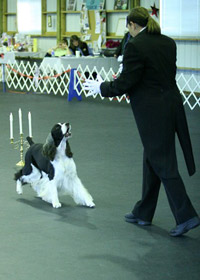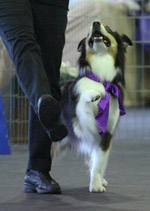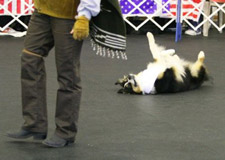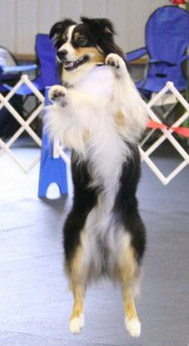Click here to watch a
video of Michele and
Cabo performing
Mack the Knife
What were the origins of your work with animals?

Michele Pouliot and
a guide dog in training
I started out as a little girl with a huge love for horses and dogs but, alas, my parents would not let me have a dog. Thankfully, my father got me a horse when I was 13 years old. Horses took up all of my spare time through high school and led to my enrollment in the college level program at Linda and Went Tellington's Pacific Coast Equestrian Research Farm. Under Linda and Went's direction, I achieved the school's highest riding level and then became an instructor for them.
Linda connected me with the owner of a new equestrian center in North Dakota who needed an instructor to run their program. While in North Dakota, I acquired my first dog and was excited about learning how to train my new puppy. I was giving riding lessons to a woman who trained dogs locally, so once a week we exchanged lessons. She was my introduction to basic obedience training. Although her training was all via corrective methods, she stressed the quality, quantity, and effective timing of praise rewards to motivate the dog. That initial focus on quality praise reward would benefit me in years to come, and certainly was responsible for my happy working dogs.
How did this initial exposure evolve into working with guide dogs?

Michele and Cabo in Phantom of the Opera
After one cold winter in North Dakota, I moved back to California and continued working in the equine industry. At the same time, I started competing in obedience trials with my pet Labrador. My success in these competitions led to some opportunities to give lessons and train dogs for clients. Quickly, I became fascinated with the similarities and the differences in training dogs and horses.
In 1973 I read a magazine article about training dogs to guide blind people, and I instantly knew that was what I wanted to do. I wrote to three guide dog programs and received letters back from only two. I still have one of those letters hanging on my office wall, as it stated, "...women do not have the physical or mental strength necessary to train guide dogs..."
The other letter invited me to interview for an apprenticeship at Guide Dogs for the Blind (GDB) in San Rafael, California. As it turns out, my timing was good. If I had written a year earlier, I would have received a response letter from GDB similar to my other discouraging response. GDB had just decided to open apprenticeships to women.
So I arrived for my first day of employment with 12 skeptical men as my coworkers—but that's another story.
In my 34 years with Guide Dogs for the Blind, the dogs have been my true teachers along the path of self-improvement. I have personally trained over 350 guide dogs and placed them with their blind handlers. Instructing blind handlers has also been a tremendously rewarding and valuable learning experience. Training so many dogs to perform very difficult tasks has been an extraordinary opportunity to learn effective training skills.

Michele and Listo kicking right
How did you first encounter clicker training?
I read Don't Shoot the Dog years ago and it made me look at training differently—thank you, Karen! I have always been on a mission to improve my training, but this changed the direction of my mission.
I first remember fooling around with clicker training by training all my pet dogs and horses on the property to nose target a stick. Not only was I amazed at how quickly they learned, I was shocked to see all the horses learn faster than the dogs. I attribute that to the fact that my three dogs all had traditional training backgrounds that made them less inspired to "invent." The horses had no reluctance to try and figure out how to make me click.
That first experiment with clicker training started an ongoing learning and application of clicker training in all my hobby training. As I realized the power in this training, I sought to find ways to bring it into guide dog work. Luckily, I had just been placed in a new position—Director of Research and Development—and my job was to find ways to improve our techniques and service to dogs and clients. How perfect was that? The rest is history.
What was the first significant training challenge you overcame with the clicker?

Listo stays “dead”
I was working with a dog who was very surface-sensitive and had a strongly ingrained avoidance of any sort of metal or cement plate on the sidewalk. This dog also would bolt nervously through doorways. This is a real problem in guide dog work because if a dog is overly focused on avoiding surface changes, the dog will not be able to focus on clearing the blind handler away from obstacles. Historically, dogs with this extreme surface avoidance problem would be dropped from the guide dog program. I used the opportunity to see if clicker training could lessen his avoidance behaviors. I worked with this dog via clicker techniques for just two days and was amazed at how quickly he willingly walked on even the most difficult of metal grates in his path. His nervous bolting through doorways also improved notably in just those two days. Overall, I was astounded by how quickly I was able to alter a very ingrained behavior. This was one of my initial "wow" moments in recognizing the power of clicker techniques.
How did you discover freestyle? You've achieved a lot of success in a short amount of time.

Michele and Cabo in Phantom of the Opera
Over the years I'd continued my competitive dog sports hobby, focusing on obedience with three Obedience Trial Champion (OTCH) Labradors and one Utility Dog (UD) English springer (retired due to cataracts with 94 OTCH points). I moved on to agility competition through the 1990s with my own English springer and Australian shepherd, but expanded to training some client dogs for titles in both agility and obedience.
Somewhere around the year 2000, I saw video of a musical freestyle routine that knocked my socks off. I wanted to learn more about it, but didn't find any information for a few years. Two years ago I had the opportunity to work with a wonderful freestyler, and I was hooked. Canine freestyle taps a creative chord in me, alongside my love of training behaviors that are both fun and challenging. Needless to say, I sold all my agility equipment to buy rubber matting and mirrors for my training area. I'm now a freestyle junkie.
I still consider myself new to freestyle and I certainly am no "dancer." I do have a creative mind and love to invent new behaviors not seen before. That's becoming harder to do now, with so many talented freestylers across the globe. My two current dogs are very talented in their own ways. My springer, Cabo, is a beautiful dog, with gorgeous movement, so just watching him heel to music can be entertaining. My Aussie, Listo, is an unbelievable athlete with great physical talent. If a physical move is even possible for a 50 pound dog, I'm sure he can do it.

Cabo jumps the candelabra
in Phantom of the Opera
My success in competing in freestyle so far has only motivated me to come up with even better routines. Having people say they were inspired, overwhelmed, and entertained is very rewarding for all the time put into creating a performance. One of the key reasons my routines are so well received is that I tailor them to the individual dogs. Phantom of the Opera is such a natural fit for Cabo, as is The Good, the Bad, and the Ugly for Listo. If you tried to switch dogs for those routines, it wouldn't be nearly as effective. I feel the personality of the dog needs to fit the "personality" of the routine. I remember how my emotions were touched when I first saw Attila and Fly do their Charlie Chaplin routine—that is my freestyle goal, to create routines that evoke those reactions and emotions in the audience. So far, I have been honored to receive four perfect scores of "10" for Artistic Impression.
On top of the artistic element, you certainly need the technical part of the performance to be precise and impressive. That's where clicker training comes in. I would not have been able to train the majority of my freestyle routine behaviors without the power of clicker training. Freestyle and clicker training are a perfect match.
How difficult was it, the first time you attempted a freestyle routine?

Listo performs a standing jump
I was very reluctant when I first started freestyle and only took the plunge with the help of a great freestyle trainer, Brigitte Scalabas. I was lucky that Brigitte and her husband moved to Portland, Oregon, for a year and I was able to take lessons from her. Brigitte helped me choreograph my first routines but when I told her my visions for more advanced routines, she pushed me out of the nest, so to speak. I fully choreographed my last four routines myself and had the full vision of those routines prior to training them. It made the training harder, as I envisioned a lot of behaviors for the music that my dogs did not know yet, but it resulted in some pretty cool routines. It took eight months for me to complete the training for The Good, the Bad, and the Ugly due to so many difficult behaviors based on my "vision." The training of many of the behaviors was challenging, but I love a challenge. One thing is for sure, at least half of those behaviors I could not have trained without the clicker!
How do you feel about joining the ClickerExpo faculty?
I am honored and feel a bit humble about it. I look up to so many faculty members as teachers for me to learn from; it's quite exciting for me. As an audience member at previous ClickerExpos, I came away with more tools, more understanding, and renewed motivation to expand and improve. I only hope I can offer the same to attendees of my 2008 sessions.



Post new comment